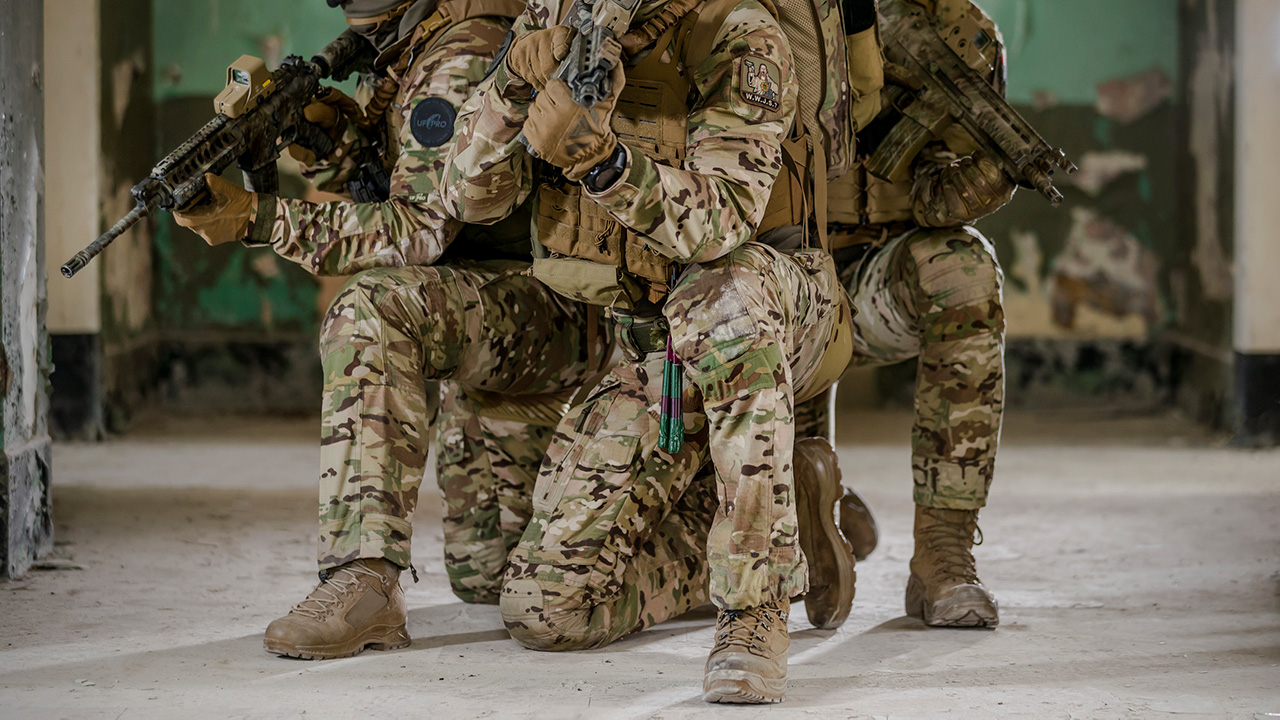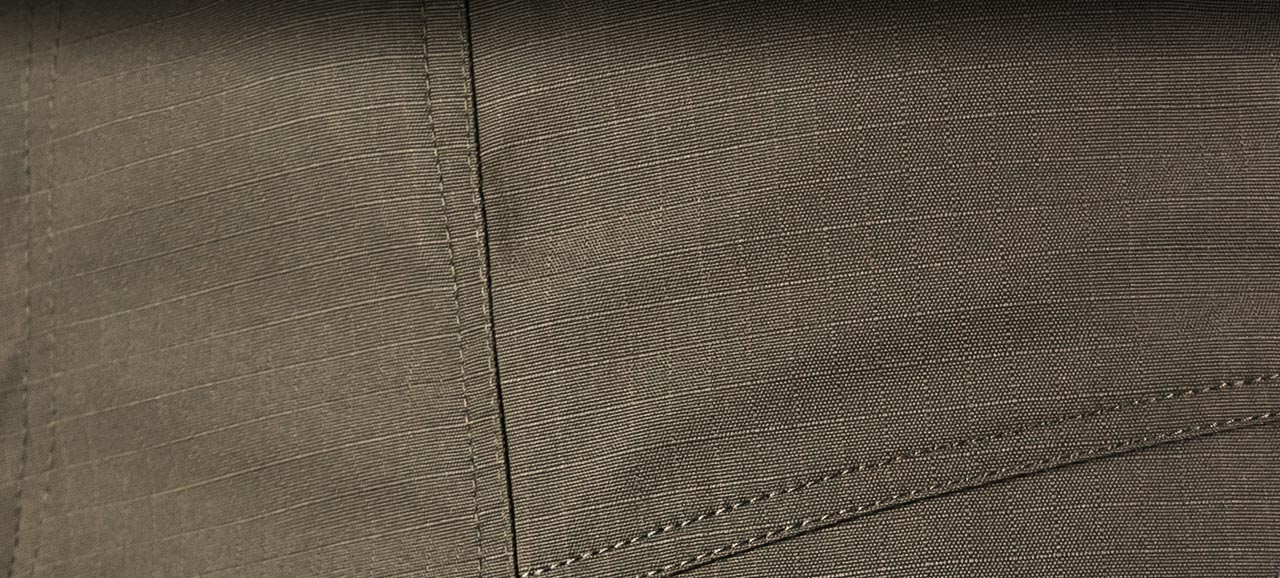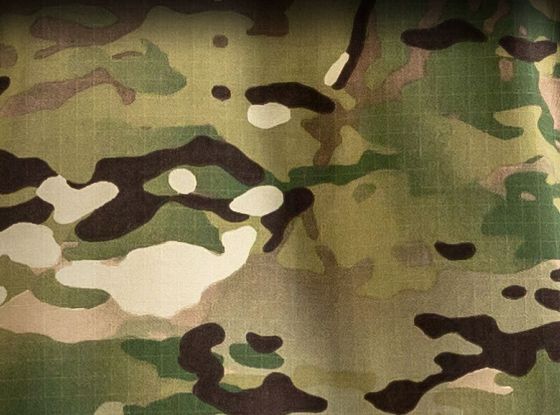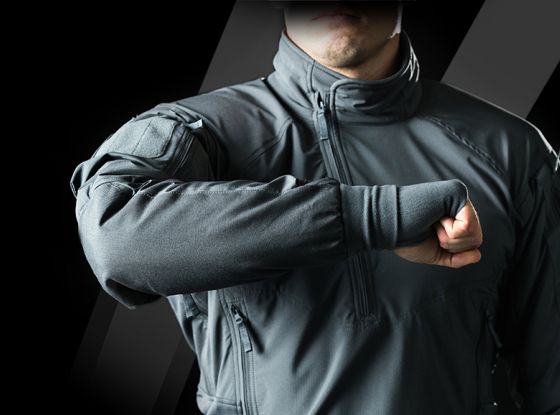Ripstop refers to a textile fibre-weaving technique that makes finished goods more durable. It is arguably the tactical-clothing world’s best-known weaving technique (indeed, practically every tactical garment manufacturer employs it). Twill, knitting, and other techniques all bring something unique and valuable to the table, but none so much as ripstop. In this post, we examine why ripstop is so widely favored by tactical gear-makers.
In this blog post:
Introduction
Frequently, you’ll encounter the word “ripstop” as you browse tactical items, be they made from nylon-cotton blends (NyCo) or polyester-cotton (PolyCo) fabric.
Ripstop is the name of a textile fibre weave technique. Most people assume that this weave has something to do with stopping rips from occurring. It doesn’t. What it does is stop rips from spreading once they begin.
In technical terms, ripstop prevents a tear from fully breaking the structure of the fabric. A tear might get started, but it will extend no further than the weave’s thick reinforcement yarns located a few millimeters away.
This capability makes ripstop ideal for tactical use—especially in situations where a tear develops while the wearer is in the middle of an op and has no way to change clothes.
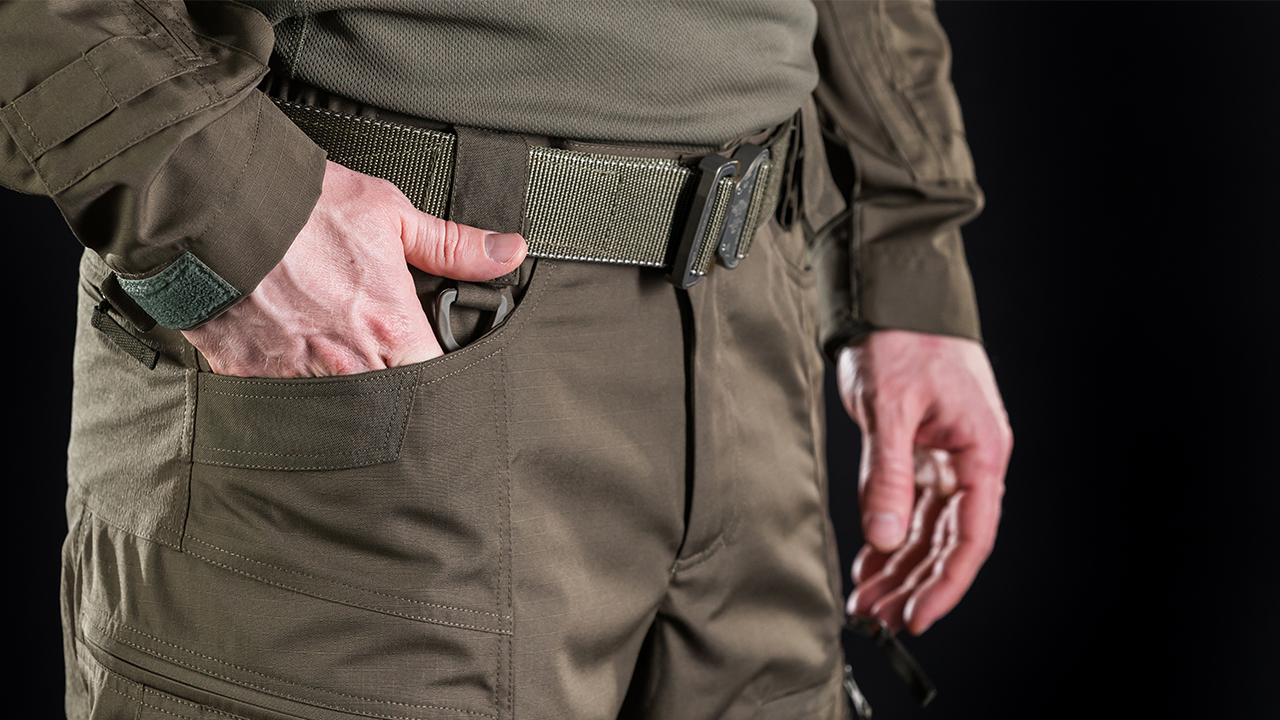
About ripstop
A brief history of ripstop fabric
The ripstop weave technique traces back to World War II. At the time, there was a great deal of concern among the allies about rips ruining parachutes (especially while in use), so textile researchers set about trying to come up with a solution.
Much of that research was conducted at labs owned by or affiliated with the DuPont chemical company which was also spearheading the production of nylon-based parachute canopies. It was logical, then, for DuPont to include development of ripstop weave technique in its overall work on parachutes.
But it was logical for another reason.
The ripstop weave requires a reinforcer yarn in order to work. This yarn needs to be thick and strong. And nylon is nothing if not thick and strong.
Once the DuPont team was satisfied with the viability of their ripstop fabric weaving technique, they handed it over to the allies for the making of tougher parachutes. Ripstop appeared to be off to a promising start.
However, nothing more was done to further develop ripstop until the decade of the 1960s. That’s when all the evolutionary action really took place. By 1980, ripstop fabric had advanced to the point where the tactical industry was making use of it in BDUs and for many other types of gear that needed to be able to stand up to relentless wear and tear.
FAQs
Who invented ripstop?
We don’t know the name of the actual inventor of ripstop, but we can safely say that ripstop fabrics made their first real appearance in the early 1940s. It wasn’t until 1 May 1962 that an initial ripstop patent was filed with the U.S. government (the patent-seekers were inventors Louis Weiner and Harold H. Brandt who titled their filing “Parachute Fabric Containing Stretch and Non-Stretch Type Ripstops”).
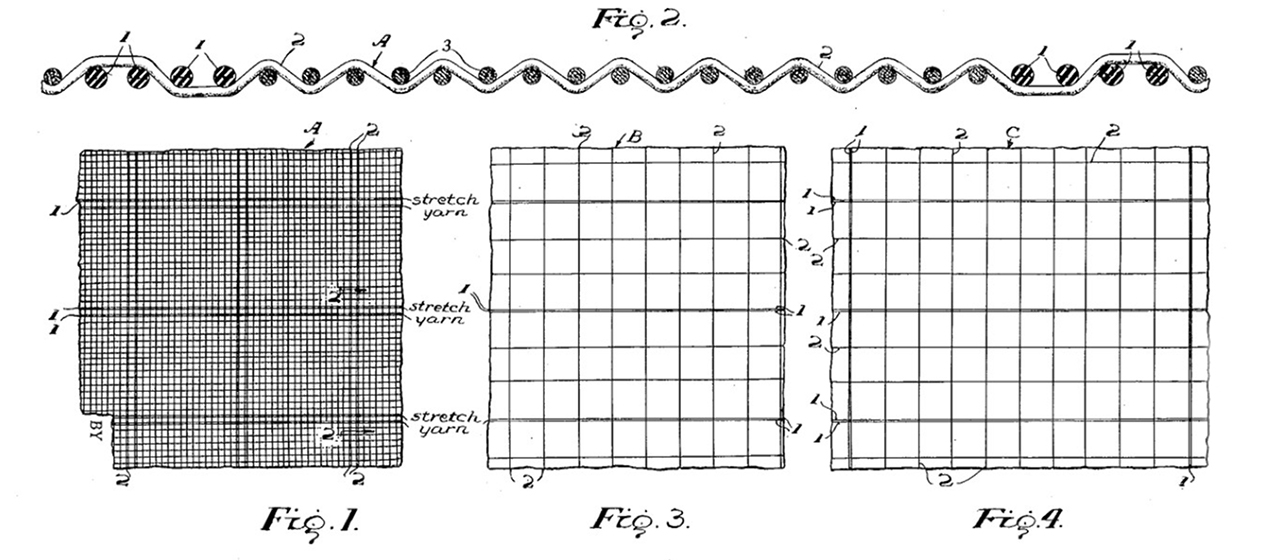
Image source: Google Patents
What is ripstop fabric?
Ripstop fabric is any fabric constructed using the ripstop weaving technique. The technique is recognised by its square pattern and prominent presence of thick reinforcement yarns.
Does ripstop nylon fray?
There appears to be no correlation between this specific weaving technique and increased fraying.
Is nylon ripstop fabric waterproof?
No, but it can be made waterproof or given water-repellancy. Waterproofing requires the fabric be laminated; water-repellancy requires the fibres be impregnated.
Is nylon ripstop breathable?
The weaving technique has no effect on breathability. Breathability is characterised by three dimensions: air; water permeability; and water-volume absorption. Ripstop tends to feel breathable, but that’s because cotton—a highly breathable fabric—is often used as one of the materials in the weave.
Breathability is primarily affected by the density of the weave. The more densely woven the fabric, the less breathability it offers. Ripstop in one sense can be associated with a dense weave: to propagate greater durability (less tearing), more yarn is added to a “segment” (also known as the ripstop square). However, this same construction strategy can also yield larger air holes, which allows for better breathability but at the sacrifice of durability.
Breathability is also primarily affected by the type of fabric used in the garment. A fabric characterized by fluffy fibres will lack breathability when compared to one without fluffy fibres. Indeed, the fluffier the fibres, the less breathable the fabric feels.
What is ripstop nylon fabric?
Ripstop nylon fabric is a term that means the fabric’s body threads and reinforcement threads are entirely nylon.
Ripstop structure
Exploring the structure of ripstop helps us better understand this fabric.
Like many common fabrics, ripstop has two distinct planes or dimensions: horizontal and vertical.
Technically, ripstop is what the textile industry refers to as a “plainweaver”. But it’s more accurate to say that ripstop employs a special variant of plainweaving construction. This construction entails “simple” up and down alternating cross-hatches always intertwined with two fibres.
Microscope images of three fabrics: ripstop (a), plain weave (b) and nonwoven (c).

Image source: Researchgate.net
The image above demonstrates this construction and compares it to two others. If you were to examine under a microscope a piece of ripstop, you’d immediately notice the crisp lines and uniform spacing of the construction. Then, if you viewed a piece of material from a regular t-shirt, you’d see a significantly less crispness and uniformity.
The structure of a fabric is also impacted by its warp and weft. Think of warp as the fabric fill-in while the weft is the yarn woven in between. The image below makes that a bit more comprehensible.
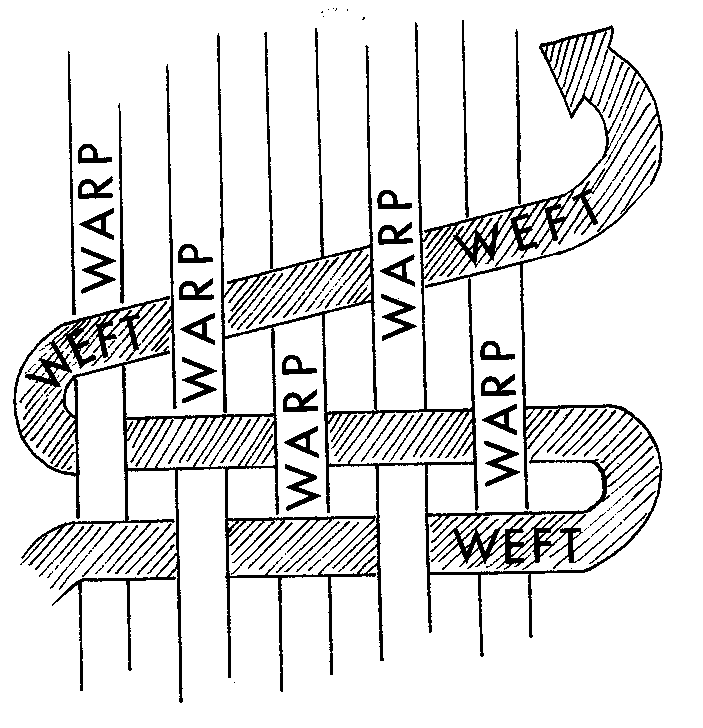
Image source: Pinterest.com
One other very important structural characteristic of ripstop is the thing that allows it to stop rips. That thing is its yarn thickness (which also happens to correlate with weave technique). In a ripstop fabric, thicker yarn is placed at intervals of 5 mm to 8mm (or 0.2 to 0.3 inches).
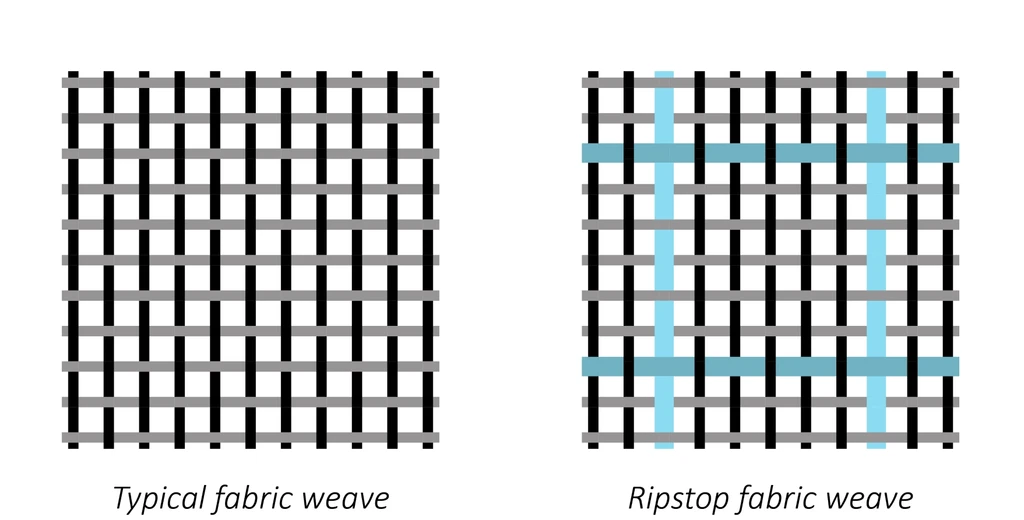
Image source: Matadorup.com
In the illustration above, the thicker yarn (depicted in blue) serves as a reinforcing thread—or rib—that’s much higher in tensile strength than the threads adjacent it. These ribs increase the fabric’s tear-propigation resistance strength.
(For the record, we at UF PRO use double these yarns in order to even further increase the ability to stop tears from spreading).
Higher strength (and greater durability) is also achievable by more closely spacing the construction of the main pattern. However, this denser construction also increases the weight of the fabric.
One caveat we always keep in mind is that the structure doesn’t reveal much about the base fibres of the yarns used. Indeed, NyCo ripstop nomenclature can mean different things in different scenarios.
Let’s look at an example of NyCo ripstop to see how this can play out.
The fact that you have NYCO (nylon-cotton blend) ripstop tells you about the structure, but nothing about the nylon’s denier nor about the cotton’s quality—both of which significantly affect the performance of the final product.
To avoid problems that might arise from this lack of clarity, there are always standard tests that can be conducted. The data for our NyCo Ripstop fabric is:
- warp 69N
- weft 52N
Why do we primarily use ripstop? Mostly because it’s a high-performing fabric perfect for our clothing—it’s strong, it’s readily available for different colours, and (despite being top-of-class), ripstop is also an economically efficient fabric. Plus, it’s visually striking.
We also like the ease with which different properties can be achieved simply by incorporating various materials. For instance, antistatic fabrics (which resemble ripstop) come with their squares made from carbon fibres—the construction remains the same, but the carbon adds those desirable antistatic characteristics. Another example, NyCo ripstop can be made even stronger with the addition of more nylon.
Other suitable options
Twill weaves
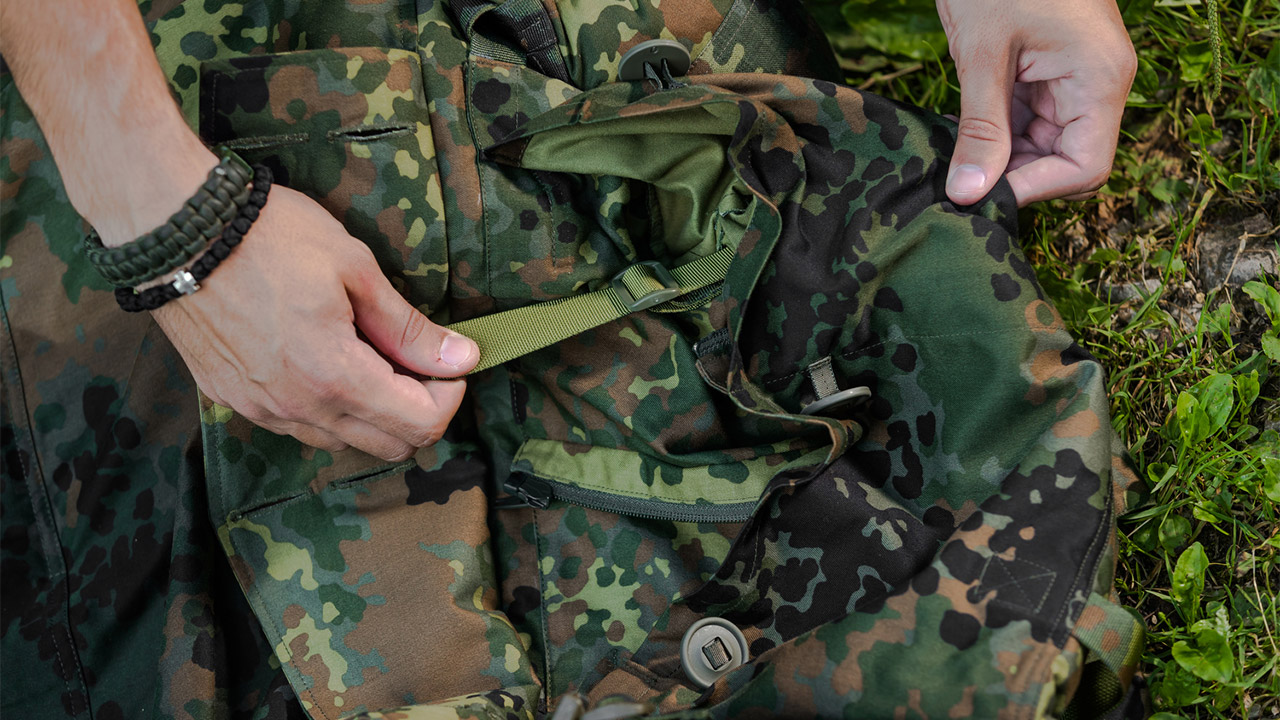
In the tactical field, ripstop’s most recognised competitor is the twill weave found in Germany’s Flecktarn gear. But it’s a weave based on a different construction and different fibre (Flecktarn is ordinarily a 35-percent polyester and 65-percent cotton blend).
You might wonder if there are disadvantages to twill weaves. The answer is yes. In our opinion, a twill fabric is too weak for what is intended. It takes comparatively little force to break the weft and twill dimensions. That’s due to the presence of the cotton (in a twill weave, there’s usually more cotton than polyester). Cotton, being by far the weaker of the two fibres, becomes the fabric’s Achille’s heel.
You might also wonder about the corollary: are there any advantages to using twill construction? Again the answer is yes. Owing to the cotton, twill is more comfortable to wear for long periods.
UF PRO tactical gear using ripstop
